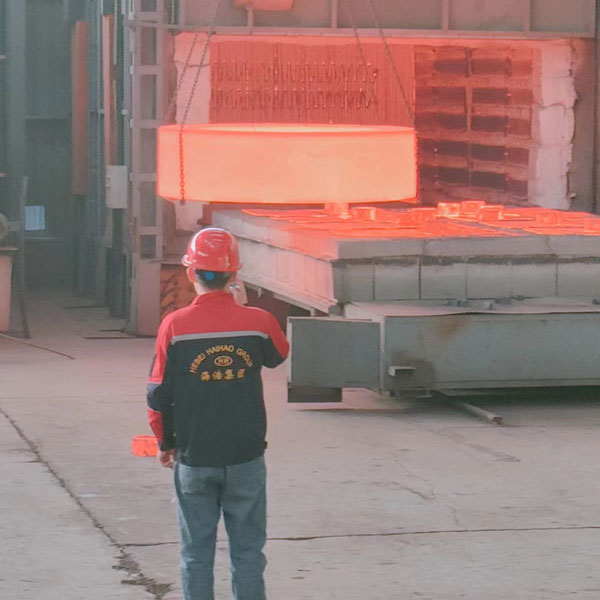Heat treatment in petrochemical equipment
1.Concept of Heat Treatment
Heat treatment involves heating metal to a specified temperature, maintaining it for a period, and then cooling it at a controlled rate to achieve desired microstructures and properties. In construction, heat treatment typically refers to the heat treatment of weld joints (heat-affected zones). This process involves uniformly heating the weld joint to a specific temperature, holding it, and then cooling it.

Heat Treatment
2.Importance of Heat Treatment
Heat treatment of weld joints helps prevent brittle fracture, delayed cracking, stress corrosion, and hydrogen embrittlement. Proper heat treatment can relieve welding residual stress, soften hardened zones, improve microstructure, reduce hydrogen content, and enhance corrosion resistance, impact toughness, and creep limit. However, improper heat treatment can degrade the performance of the joint.
Pre-Weld Heating
Preheating is a crucial process in welding, especially for thick workpieces. Preheating the weldment can prevent or reduce stress generation. For welding important structures, such as high-pressure thick-walled vessels or weldments with poor plasticity and strong hardening tendencies, preheating is typically necessary to prevent cracking during welding. Preheating reduces the temperature difference between the weld metal and the base material, increases the initial temperature of the weld joint, reduces shrinkage stress, lowers the cooling rate of the weld, controls the transformation of the steel structure, avoids the formation of brittle martensite in the heat-affected zone, reduces local hardening, and improves weld quality. Preheating also facilitates gas and slag discharge, reducing defects such as porosity and slag inclusion.
The need for preheating and the preheating temperature should be determined based on factors such as the chemical composition of the steel plate, plate thickness, structural rigidity of the vessel, welding form, welding method, welding materials, and environmental temperature.

Heat treatment for stainless steel forgings
Post-Weld Heat Treatment
1.Residual Stress from Welding
Residual stress is caused by uneven temperature distribution, thermal expansion and contraction of the weld metal during welding, making it inevitable in welding construction. The most common method to relieve residual stress is high-temperature tempering. This involves heating the weldment in a heat treatment furnace to a certain temperature, holding it for a specific time, and using the reduced yield limit of the material at high temperatures to allow plastic flow in areas of high internal stress, thereby reducing the stress.
The effect of post-weld heat treatment on the tensile strength and creep limit of the metal depends on the heat treatment temperature and holding time. The impact on the impact toughness of weld metal varies with the type of steel.
2.Selection of Heat Treatment Methods
Post-weld heat treatment generally involves single high-temperature tempering or normalization followed by high-temperature tempering. For gas-welded joints, normalization followed by high-temperature tempering is used due to the coarse grains in the weld and heat-affected zone, which require grain refinement. Normalization alone cannot eliminate residual stress, so high-temperature tempering is needed. Single medium-temperature tempering is used for assembling large, ordinary low-carbon steel vessels on site to partially eliminate residual stress and dehydrogenate. In most cases, single high-temperature tempering is chosen. Heating and cooling during heat treatment should not be too rapid to ensure uniform temperature throughout the inner and outer walls.
3.Heating Methods for Post-Weld Heat Treatment
Induction Heating: This method uses alternating magnetic fields to generate induced potential in the steel, causing it to heat due to eddy currents and magnetic hysteresis. Induction heating is commonly used in engineering due to its simplicity.
Radiant Heating: Radiant heating transfers heat from a heat source to the metal surface, which then conducts the heat to other areas. This method results in a significant temperature difference between the inner and outer walls, making it less effective than induction heating. Common radiant heating methods include flame heating, resistance furnace heating, and infrared heating.

Heat Treatment Flange Production
Overall Heat Treatment
Overall heat treatment is used to eliminate welding-induced stress, stabilize geometric dimensions, alter the metallographic structure, enhance metal toughness and stress resistance, and prevent cracking. Local heating during welding changes the metallographic structure, creating internal stress, while the weld stress distribution becomes complex. To relieve residual stress and reduce local hardening of the metallographic structure near the weld, overall heat treatment is employed. Methods such as internal combustion and electric heating are used for overall heat treatment of spherical tank assemblies.
Equipment Weld Heat Treatment
On-site assembled equipment weld heat treatment should comply with the conditions provided in the product certificate and drawings, as well as relevant provisions of GB150 “Steel Pressure Vessels” and GB50236 “Construction and Acceptance Standards for Site Equipment and Process Piping Welding Engineering.
1).Vessels and Pressure Components Meeting the Following Conditions Should Be Heat Treated:
A and B type welds with base material nominal thicknesses of:
(1)Carbon steel greater than 34mm
(2)16MnR greater than 30mm
(3)15MnVR greater than 28mm
(4)Other low-alloy steels of any thickness
For A and B type welds of different thicknesses, the thinner part is considered. For A and B type welds of different steel types, heat treatment requirements are determined by the type of steel.
2).Cylinders Formed by Cold or Medium Temperature Forming with Thicknesses Meeting the Following Conditions:
(1)Carbon steel and 16MnR nominal thickness not greater than or less than 3% of the design diameter (D).
(2)Other low-alloy steels nominal thickness not greater than or less than 2.5% of the design diameter (D).
3).Vessels Indicated in Drawings as Subject to Stress Corrosion.
4).Vessels Indicated in Drawings as Containing Extremely Hazardous or Highly Dangerous Media.
5).Surface Treatment for Corrosion-Resistant Austenitic Stainless Steel and Clad Steel Plate Vessels. These vessels should undergo pickling and passivation.
6).Dehydrogenation Treatment: If the vessel is to undergo residual stress elimination heat treatment immediately after welding, dehydrogenation treatment can be omitted.

